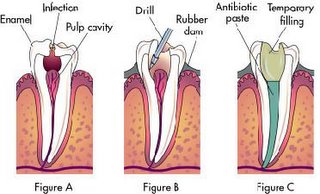
Once upon a time, if you had a tooth with a diseased nerve, you'd probably lose that tooth. Today, with a special dental procedure called a root canal therapy you may save that tooth. Inside each tooth is the pulp which provides nutrients and nerves to the tooth, it runs like a thread down through the root. When the pulp is diseased or injured, the pulp tissue dies. If you don't remove it, your tooth gets infected and you could lose it. After the dentist removes the pulp, the root canal is cleaned and sealed off to protect it. Then your dentist places a crown over the tooth to help make it stronger.
Most of the time, a root canal is a relatively simple procedure with little or no discomfort involving one to three visits. Best of all, it can save your tooth and your smile!
Figure A is when infection reaches the root canal system.Figure B is the procedure which the dentist drill the tooth to drain the pus and Figure C is the filling for the tooth after completion of RCT.
The procedure
Here is what you can expect when you schedule a root canal treatment.
On the initial visit:Local anesthetic usually is given, to maintainpatient comfort
The affected tooth is isolated from saliva with arubberlike sheet called a dam.An opening is made through the crown of thetooth. The pulp is removed, and then the root iscleaned and shaped. Medication may be added tothe pulp chamber and root canal(s) to help eliminatebacteria.A temporary filling is placed in the crownopening to keepsaliva out. Antibioticsmay be prescribedif an infectionis present andhas spread beyondthe end of theroot(s).On the nextvisit:The temporaryfilling is removed.The root canalis filled and permanentlysealed.(A metal or plasticrod or post may beplaced in the rootcanal for structuralsupport.)If an endodontistperforms theprocedure, he orshe usually willsend you back to your general dentist for preparationof a crown to be placed on the tooth. Crownsare made from a variety of materials, dependingon the location of the tooth, the color of the toothand the amount of natural tooth remaining. Discusswith your dentist which option is best foryou.THE REST IS UP TO YOUThe restored tooth can remain healthy as long asits roots are nourished by the surrounding tissues.Good oral hygiene at home and regulardental visits can help prevent tooth decay andgum disease. If you take good care of it, therestored tooth could last a lifetime.
No comments:
Post a Comment